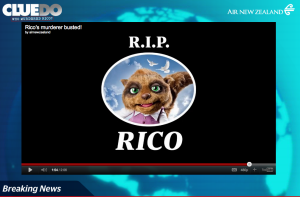No longer the dominion of geeky young men, gaming has hit the mainstream with people of all ages playing on smartphones, tablets, Wii’s and more. How airlines, hotels, tour operators and more are turning players into customers.
Editor’s Note: The following "gamification" trend piece is offered for awareness building versus an explicit recommendation to pursue the concept. Future ATN articles are expected to provide more background and examples about how gamification is and/or might be applied in the adventure tourism sector.
By Nicole Petrak, Assistant Editor & Special Projects to ATTA
 The buzz around ‘gamification’ has been building for awhile, with research and strategic consulting firms like Gartner (technology specialization) and M2 Research (gaming specialization) predicting the trend will soon become widely popular across most major industries. The term 'gamification' means taking gaming dynamics and applying them to other areas - business, entertainment, science, social media, health care, cityplanning, consumer or technology products and much more - to solve a problem: create viral PR and buzz, increase loyalty or compliance, crowdsource new products or solutions, gain feedback, or recruit talent, as a few examples.
The buzz around ‘gamification’ has been building for awhile, with research and strategic consulting firms like Gartner (technology specialization) and M2 Research (gaming specialization) predicting the trend will soon become widely popular across most major industries. The term 'gamification' means taking gaming dynamics and applying them to other areas - business, entertainment, science, social media, health care, cityplanning, consumer or technology products and much more - to solve a problem: create viral PR and buzz, increase loyalty or compliance, crowdsource new products or solutions, gain feedback, or recruit talent, as a few examples.
Gartner’s recent study forecasts that over 70 percent of the Forbes Global 2000 companies will incorporate gamified applications by 2012, and that “a gamified service for consumer goods marketing and customer retention will become as important as Facebook, eBay or Amazon.” And by 2016, the U.S. alone will see the new industry reach $2.8 billion. So, it’s no wonder that the travel industry is jumping on the bandwagon, with the World Travel Market 2011 Report naming gamification as a major trend for the coming years, one that appeals to consumers across all age demographics. Data suggests that interest peaks in the 18-34 range, but a solid 23 percent of all gamers are “aged”.
However, eMarketer reveals that regular social gaming, such as Farmville or Words with Friends, has been most popular among the middle-aged to Boomer set, with interest growing in younger groups. Given that the 45-65 target demographic is currently the most important to a wide range of travel companies, it’s key to recognize that this group is already primed to embrace gamification.
 According to the WTM 2011 Report and other industry sources, gamification can range from consumers participating in one or several layers of actual games, or sharing opinions, experiences or media to help generate what brands hope will be a viral type of brand loyalty and awareness. The awards range from points, badges and status level (and presumably the intrinsic or social satisfaction of achievement) to real-life bonuses of discounts, air miles, or the possibility of winning anything from trips to iPads.
According to the WTM 2011 Report and other industry sources, gamification can range from consumers participating in one or several layers of actual games, or sharing opinions, experiences or media to help generate what brands hope will be a viral type of brand loyalty and awareness. The awards range from points, badges and status level (and presumably the intrinsic or social satisfaction of achievement) to real-life bonuses of discounts, air miles, or the possibility of winning anything from trips to iPads.
Clearly hotels, airlines and other denizens of the traditional loyalty program space will easily incorporate this new addition to their familiar framework - and should be quick to consider their value in an era where flash deals and bargain-hunting have undercut the value of brand loyalty to most people. Reevaluating not only the tangible, fiscal awards people seek but also intrinsic and status-related benefits, and packaging them in an engaging, rewarding and social platform will become the new rule for all companies who wish to compete in the changing demands of their audiences. Gamification offers just such an opportunity through online games, or games that reach travelers on the road through location-based mobile tech and social networks (such as Foursquare and Facebook Places).
Gamification is not a new concept, but a rapidly growing trend driven by decreasing costs in online development and the increasing online interactions of social networking. Some industries are ripe for leveraging gamification today, yet we see this as a near future opportunity for the adventure travel industry to watch,” says Jason Reckers, Director of Operations and Online Strategies for the Adventure Travel Trade Association. “Stay tuned and start thinking about how ‘games’ can be leveraged to help make the experience of Adventure Travel before, during, and after the trip even more engaging for your clients.
Here are some examples across different types of providers in the travel industry to get you started.
Airlines

Two different examples of airline approach to gamification can extend lessons to any company dealing with a smaller than usual marketing budget on how focusing on high-quality social or viral aspects of a campaign can bypass the need for extensive budget.
Airlinetrends.com reports that while carriers such as Lufthansa, Air New Zealand, Virgin America and JetBlue have launched campaigns which gives customers rewards (online badges and social markers) for ‘checking in’ to their virtual venues, small airline Estonian Air became the first airline globally to launch a social loyalty program (based on Facebook) this October. AirScore allows fliers to redeem promotional awards ranging from premium check-in, flight discounts, and lounge access for activities such as writing reviews, tweeting Estonian Air deals, booking tickets, sharing promotions, and taking polls. The difference is that consumers aren’t just rewarded for flying, or even for checking-in in front of their friends - but also for becoming strong brand advocates who are vocal about and active with their loyalty. CEO Tero Taskila says:
Using traditional channels to promote the airline and the country abroad requires a big budget and human resources. Therefore, we have decided to use Facebook and also other social media for that purpose. […] Social Media is one of the most effective ways to market and promote brands across the borders.
Air New Zealand has taken a different tact, utilizing fun online content with a continuing storyline to develop an online following. After creating a mascot last year named Rico (whose online video stunts - including an interview with Baywatch celeb David Hasselfhof - has generated popularity and praise for their use of social media), in a surprising and clever twist, the airline released a video declaring Rico had been the victim of a “high-profile murder” and launched a “whodunnit” game that has so far attracted over 7,500 active “investigators.”
Hotels
Gaming can also be used to strengthen ties to a younger audience - as long as the promotion doesn’t compete with the image or relationship you have with older, already-loyal followers.
InterContinental Hotels Group decided to amp up their loyalty program with a daily online trivia game which awarded people with the quickest, correct answers with free miles - the first loyalty program to do so. The “Win It In a Minute” campaign was developed to foster better loyalty among their younger consumers - a demographic known for its lack of brand loyalty for everything except the most cultish and status-oriented objects (i.e. Apple). Don Berg, VP of IHG’s Loyalty Program, remarked:
We’ve been thinking about gaming for quite a while. In the hotel industry, loyalty program members tend to be in the mid-40s range, and we are constantly seeking ways to establish engagement with newer[...] younger members, who have a great affinity for online gaming in general. At the same time, the game also appeals to our bread-and-butter members’ love of travel.
Tour Operators
Not a lot of compelling examples for gamification used by tour operators exist online, so we asked around to multiple service vendors in the industry for ideas on what could be done. Josh Kramer, Founder of Leapfrog Group, a full-service strategic online and digital product development company, stressed:
The key to gamification is to keep the actions of the consumer to be intrinsically valuable. The game is a means to get people's attention and to keep their attention, their interest should be based on the direct value of what they receive.
Among his suggestions:
- Creating an online challenge involving video content and trivia questions as a fun way for prospective clients to learn about your tour packages
- Creating a community of users on your travel site and utilize a crowdsourcing game that would encourage people to come back and check again later. Example: Let people contribute one word goals for their vacation and have them invite friends to provide their own words; you can run statistics on the words and show people how they are similar to other friends so they can see who they may most (or least!) want to vacation with.
- Let people identify what interests them in a vacation package through a ‘make your own adventure’ game. This identifies what people like and offers free advertising through user generated content if you make it available for them to share on Facebook.
For instance, do user reviews inspire more purchases and increase SEO? Is there value in having the customer share links to their favorite vacation deals? If the primary goal of the company is transactions, what other user behaviors help lead to that goal? There are a whole host of techniques around gamification that can be used to increase these behaviors.
DeMonte added that Badgeville customers have seen increases in such online objectives ranging from 20 to 150 percent, and that gamification could also be used to enrich live experiences
One of our clients is a large interactive agency that powers mobile experiences at vacation resorts. Since our software allows the tracking of any behavior with relevant metadata (i.e. John just entered the pool area at 3pm before the Beach Party), this information can be used to create "missions" for your users to complete. Our technology can actually create proprietary location-based networks, where you can create missions where your audience needs to check-in at certain locations to earn a prize or recognition. There is a lot of opportunity in the travel space, and for tour operators, to track behavior both online and via mobile, and to drive this behavior with rewards and reputation.
Mobile Travel Applications
Whaiwhai, which began as a travel game in Italy in 2008 that allowed short-term travelers to get off the beaten path and really discover a new city by solving “enigmas” based on short stories around more locally known attractions, started off as an SMS texting game used with guidebooks. Now the group, who’s motto is “Story is what matters, Game is what triggers,” has released its first app, available for six cities, which uses the same gaming structure on the iPhone. The app includes narrative around everything from tourists spots and restaurants to historical figures, as well as quizzes, and hints that provide a scavenger-hunt type experience.
 While the reach of the app is currently limited, it shows a creative blend of storytelling principles, rich with content, within a physical game that is at once informative, mysterious and challenging, brought to individuals in real-time through technology.
While the reach of the app is currently limited, it shows a creative blend of storytelling principles, rich with content, within a physical game that is at once informative, mysterious and challenging, brought to individuals in real-time through technology.
Online Booking Sites
On the Beach, a British travel booking site, is embracing the trend wholeheartedly, providing a point-driven competition on their Facebook page, allowing users to redeem points for discounts on some of the trips they sell - points are earned through sharing videos and photos, taking part in contests and polls and sharing tips on places they’ve been:
The system appeals to people interested in getting to know popular destinations with the help of travellers who have been there before. Alistair Daly, Marketing Director at On the Beach, comments: ‘We're trying to avoid customers staring at long lists of hotel and car hire sites that are 'much of a muchness' in terms of service offering. Through the On the Beach Facebook page, customers can enjoy a much more interactive holiday booking process that allows them to get what they want, and have fun in the process.'
According to WebInTravel.com’s Yeoh Siew Hoon, Japan is ahead of the gamification curve with a population that is technologically wired-in and loves games. Hoon says the country’s largest location-based gaming company, Colopl, has 2.1 million registered users, three million page views per month, and 40 million Japanese check-ins monthly - a number higher than Foursquare’s global combined check-ins. The service is currently being used by over 1,000 travel companies, comprised (in descending order) of hotels, souvenir shops, transport companies and tour companies.
Hoon reports that CEO Kei Shibata of Japan’s largest travel meta search engines, Travel.jp and Hotel.jp (under the umbrella name Venture Republic), sees the marriage of gamification and mobile technology as a key tool in both new demand creation as well as revitalizing struggling destinations. Venture Republic has partnered with Hakuhodo Media Partners Inc., a group that has been merging apps for television programming on smartphones and location-based magazines to create games for travel companies to offer customers:
The user watches a travel TV programme at home. If they are interested in travelling to the location, they can access the specific mobile application where they can then search Travel.jp/Hotel.jp database to find a suitable tour package, hotel or flight. When the user travels to the location, he or she can play, watch the TV/movie content to review, get some location information, [or] create a photo book using his/her smart device.
This convergence of multiple platforms of technology with several engaging options for the consumer at the inspiration, booking and on-the-ground stage is indeed pretty sophisticated stuff, and as Reckers noted, not likely to be a pressing concern for most adventure travel companies in the immediate future. However, the trend will continue to grow and our industry should watch carefully for emerging ROI information and opportunities as it does.
This article will be followed up with another focused on why gamifcation is psychologically compelling to users and guidelines when considering creating gamified experiences. If you have questions or comments you’d like considered ahead of this piece, please feel free to make them in the comments section or email them to [email protected]
Photo credits:
- Chess image: Chess board photo by Bernd Moehle. Derivative by Murray Bartholomew / ATTA
- Scrabble image: Original photo by Andy. Derivative by Murray Bartholomew / ATTA.
